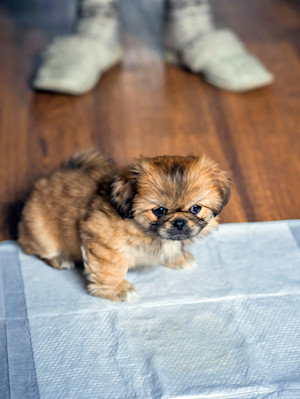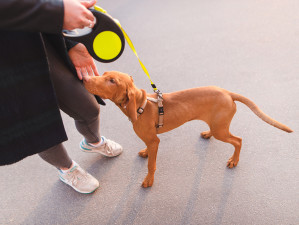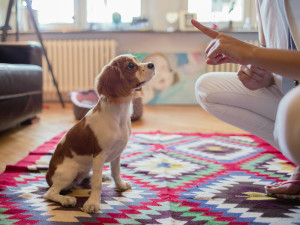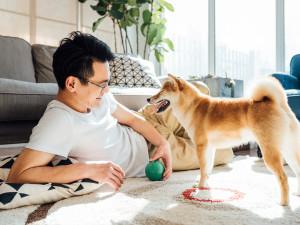How to Potty Train a Puppy: From Pee Pad to Outside
And learn how often they have to go outside.
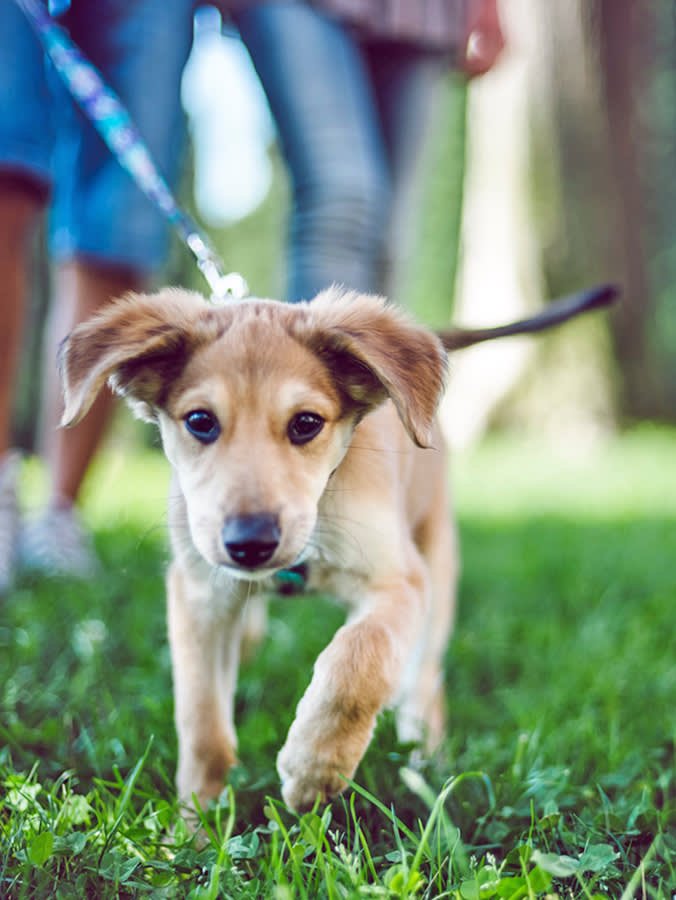
Share Article
In This Article:
How to Train Your Puppy to Pee Outside How to Potty Train a Puppy From Pee Pad to Outside Puppy Potty Training Schedule How to Train a Stubborn Puppy to Pee Outside Frequently Asked Questions
Training a puppy to pee outside requires consistency, patience, and positive reinforcement to establish good habits early on. You can effectively train your pup by creating a regular schedule, closely monitoring their behavior, and rewarding successful outdoor bathroom trips.
How to train your puppy to pee outside
Use positive reinforcement.
When training a puppy, it’s helpful to use positive reinforcement. Positive reinforcement allows you to reward your dog for doing the correct behavior over and over. When using positive reinforcement, you are rewarding your dog before they have the chance to do something wrong. This helps you establish a great routine with your dog. The more they do the correct thing and are rewarded, the more this behavior will become a habit and will help avoid behaviors you do not want.
Reward your pup as soon as they pee or poop. You will want to use a yummy treat. If your puppy is prone to accidents, it may be a good idea to get a high-value treat to use only during potty training. Puppies are easily distracted, so remember to wait until they are done going to crinkle the treat bag to reward them.

Avoid punishment for accidents.
An accident is just that, an accident your puppy is learning all about the world and is learning what is right and wrong. When you scold your dog for having an accident, you are only teaching them not use the bathroom in front of you. Since a puppy doesn't understand human language if you yell or get upset with your puppy they don’t understand ‘no don't pee here’. They are only learning that you got mad that they peed not that you are mad about where they had the accident. This may cause your puppy to continue to have accidents and instead begin to hide them from you.
Establish a consistent routine.
Establishing a routine is the best way to avoid accidents. When potty training you should always take your puppy outside right away after eating, playing, or waking from a nap. If you live in an apartment or have a long walk to get outside, it may be best to pick up your pup on the way out. This will help prevent an accident if your puppy can’t hold it en route. A timer is your best friend when potty training. As soon as your puppy goes, restart your timer again.
Potty train using a bell.
Teaching your puppy to ring a bell when they need to pee or poop is a great way to help dogs communicate the need to go outside. Choosing the correct bell that a dog can ring is important. Your dog will either nudge the bell with their nose or swat the bell with their paw. So, keep that in mind when choosing the bell to buy and where to keep it in the house.
At first, you will need to teach your puppy to ring the bell separately from using the bathroom. When introducing the bell to your dog, start by ringing the bell right before you open the door to take your puppy out. As you ring the bell each time you take your puppy to the bathroom, you are creating an association with that sound and the door opening for potty time.
Remember, potty time is not play time, so if your puppy is trying to play, ignore them by standing in one spot, holding the leash. When you beginning training, it’s best to always go to the same spot to let your puppy use the bathroom. This will help you train your dog to go to the bathroom right when they come outside, rather than sniffing and sniffing, looking for the perfect spot to go.
Now that your puppy is empty, has played a little, and is ready to learn, it’s time to train your puppy to ring the bell.
Start by allowing them to examine the bell. New things can be scary to a puppy, so let them sniff and engage with it (don’t let them play tug with it). Once you have your puppy engaging with the bell, you can reward them with a treat each time they touch the bell (if you have a more timid dog you may need to start by just rewarding them when they look over at the bell, then move to touch). Once your puppy is willingly touching the bell, you will then stop rewarding for just touching and reward it when they nudge it harder so it makes a sound.
Continue to reward them for making the bell sound until they are able to do it consistently and that it is loud enough to hear in another room. When your pup is comfortable with ringing the bell you can add it into your potty routine. Remember, if you think your puppy may have an accident, you should continue to ring the bell yourself. Otherwise, you can let your pup ring the bell and immediately take them outside.
As you begin to consistently do this, your dog will build an association with ringing the bell and going outside. Over time, your puppy will ring the bell to go outside without your help when this happens, you must take your puppy outside right away, and remember to keep them on the leash. Puppies are very smart, so you want to make sure you are training your puppy to ring the bell only to go to the bathroom not to go outside and play.
How to potty train puppy from a pee pad to outside
Yay — it’s finally time to move your puppy away from the pee pad and get them to go outside, but how do you do this? Some puppies may be easy. You may be able to take them right outside after they eat, play, or wake from a nap. If you do this, they will go because you have created a routine with these behaviors. But some puppies may have a harder time; there can be a lot of new distractions outside.
If they have trouble, you can take a used pee pad outside to start. Place it on the floor by a tree or in an area you think looks inviting for a puppy to go to the bathroom place it there and wait (with your puppy on the leash). Allow your puppy to sniff the area and when they use the bathroom reward them. Remember to be consistent, and use the same area to go to the bathroom throughout the duration of training your puppy.
Continue to do this a few times. Then, you can use a clean pee pad. Once your puppy is going consistently with the non-soiled pad, try and have them go with no pee pad at all. Remember to give your puppy a few minutes to figure it out before giving up. Puppies take time to generalize skills. Each time you add a new piece to the puzzle (or take it away in this case) it is like a new skill to your puppy.
Puppy potty training schedule
Here is a sample schedule to follow as you begin your potty training journey with your puppy. These are just general guidelines; always adjust your puppy’s schedule to meet their needs. Also, the size of your puppy may affect how often they need to go out. The amount of food or water your puppy has consumed may affect the frequency needed for bathroom breaks. Has your puppy just: woken up, played, eaten? Go right outside.
Follow this if your puppy is out and about during free time, after they have played, eaten, or slept.
New to potty training or two to three months old: Take them out 30 minutes; maximum hold time: one hour
Three to four months old: Take them out 45 minutes to one hour; maximum hold time: two hours
Four to five months: Take them out every two hours; maximum hold time: three to four hours
Five to six months: Take them out every three hours; maximum hold time: five to six hours
Follow these guidelines when your puppy is home alone and crated. They should be able to hold their pee for as many hours as the number of months old they are, plus one. (Remember these are just guidelines. Each puppy is different.)
two months: three hours
three months: four hours
four months: five hours
five months: six hours
six months: seven hours
How to train a stubborn puppy to pee outside
Consistency and reward
Some puppies are harder to train than others. The size and breed of your dog can affect how easy or hard they may be to potty train. If you find your puppy is hard to potty train, take a look at your schedule. Are you sticking to it consistently? If you aren’t, then you may need to shorten the time between potty breaks. Are there any new or added stressors or anxiety for your puppy? This can be a cause of accidents.
As always, be sure that the entire family is on board with the potty training rules and schedules, it must be followed by everyone who is home with the puppy. Always go to the same area that way your dog can smell their urine from last time, and it will remind them of what they need to do outside. Have a treat party after they go: Give them a few treats, and use a lot of praise and petting.
Puppy goes outside then pee inside: solutions
Typically, if you are taking your puppy outside only for them to come back inside and pee, they are not properly potty trained yet. Always go to the same place when taking your puppy outside do not take them on a walk to use the bathroom just stand in one area and allow them to sniff in a circle around you. This will create consistency. Once your puppy goes to the bathroom reward them with a few treats and a lot of praise.
Addressing fear, stress, or anxiety
Could something outside be scaring your puppy or giving them anxiety? This may prevent them from using the bathroom in a certain area. Keep an eye on their behavior when they are outside. Do they look stiff, crouch down, have their ears perked up, or are they quickly looking from spot to spot? There may be something outside that is causing them to be afraid, which may prevent them from going.
Dealing with regression
Potty training regression can happen. Change in your puppy’s environment or routine can be a cause for a potty training regression. If your puppy starts a new food or something upsets their stomach they may have unusual accidents. Sometimes, construction outside or extra noise can lead to anxiety, which can also cause regression.
Go back a few steps in your training to help your puppy be successful. Shorten the time between potty breaks and go back to rewarding your puppy if you have stopped.
Managing accidents calmly
Accidents are going to happen during potty training, it is not a perfect science, even with all of the consistency and treats. When an accident happens, stay calm. If you just found the accident on the floor do not bring it to your dog’s attention, just quietly clean it up.
You can not scold a dog for something they did in the past. If you catch your puppy mid-accident, calmly say, “Oops,” and redirect them to outside as fast as you can. When they finish going potty in the correct area, be sure to heavily reward them. Only give your puppy free time in the house when you know they are “empty.” This will help prevent accidents and give you more control when it comes to successful pee breaks outside.
When cleaning up an accident, use an enzymatic cleaning product and try your best to get everything. Do not use a cleaner that is ammonia-based; urine has ammonia in it. If you are use a cleaner with ammonia the area will still smell like urine and your dog may continue to pee in that area.
How to train your to puppy to pee outside when it’s cold or snowing
Training your puppy to pee outside when it’s cold or snowing is the same as training them to go outside when it is not. Depending on your dog’s breed and temperament, they may adjust to the colder weather easier than others. If your dog is affected by the cold, try a jacket. If you have a very small short-hair breed, and it’s extremely cold, you may need to enlist the help of pee pads until it gets a bit warmer. Your vet will be able to help you decide if it would be best to keep your small puppy inside for a bit during the colder months.
FAQs (People also ask):
How long does it take to house train a puppy?
All puppies are different, and it’s hard to give an exact timeline of when a specific puppy will be potty trained. Your consistency also plays a huge factor in how fast it takes for your puppy to get potty trained. With consistent training, it can take between four to six months for your puppy to be potty trained, but some puppies may take a year.
How do you train a puppy with a puppy pad?
Place your puppy on a pee pad after they have eaten, played, or just woke up, this will make it easy for you to catch your puppy in the act. Reward them for using the bathroom on the pee pad. After your puppy has used the bathroom start your timer, when it goes off place your puppy on the mat. It may be helpful to use a leash to assist with keeping them on the mat while you wait for them to go.
How long can puppies hold their pee?
Puppies can generally hold their pee for the number of months they are old plus one. So, a four month old puppy can typically hold his pee for about five hours. This timeline does not include when your puppy has just woken up, played or eaten. You should always take a puppy right out to the bathroom after those three activities.
Do some puppies have a tell before going to the bathroom?
Yes, it’s important to learn your puppies “tells” when potty training. Look out for what your puppy does right before peeing. This will help you learn when they are just about ready to go so you can better have a handle on when they need to go out. They may walk around in a circle, start barking, become restless, or start sniffing around.
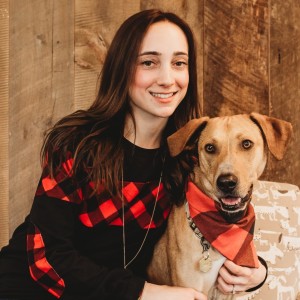
Danielle Vrabel, CPDT-KA
Danielle Vrabel is a dog trainer who earned her CPDT-KA in 2020. Danielle is a proud pet mom of five pets: two dogs, two cats, and a corn snake. Danielle has fostered over ten dogs and fifteen cats and kittens, as well as helped train shelter dogs before they are adopted. Both of Danielle’s dogs are pet therapy dogs, where she also volunteers her time helping evaluate future therapy dogs.
Related articles
![woman gives small black dog treat for sitting]()
Your Dog Should Do This 30-Day Training Challenge
It’s like your 30-day yoga challenge — except with way more training treats.
![Adorable puppy focused on learning commands at home in living room]()
Dog Training 101: What to Teach Your New Dog
In between cuddle sessions, work on these eight basic cues with your pup.
![Man laying on floor playing with dog]()
How to Puppy Proof Your Home
Is your home a danger zone for a new dog? Follow these pro tips.
Why Is My Dog Peeing So Much?
Seriously, when will it end?
![Woman walking her small black dog outside on leash.]()
Do Small Dogs Pee More Often?
Research shows that little dogs may feel the need to scent mark more frequently than big dogs.

